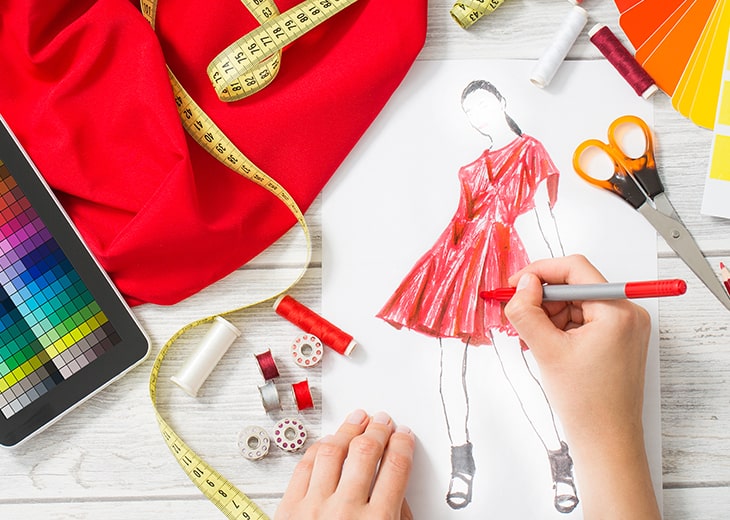If you’re in the market for a fashion design school, there are a few important things to keep in mind. One of those is the range of offerings that these schools offer.
A fashion design school provides students with the skills and techniques needed to create fashionable, trendsetting clothing. Classes cover everything from pattern-making to sewing to color theory. After completing a program, graduates are ready to begin their careers designing for high-end retailers or leading their own independent labels.
The benefits of pursuing a fashion design degree include improved job prospects and higher earning potential. In fact, according to the Bureau of Labor Statistics (BLS), the median salary for designers was $49,500 as of May 2024. Additionally, given that the industry is constantly evolving and in demand, a degree in design can provide you with an edge when searching for employment.
When choosing which school to attend, it’s important to consider what you want from your education. Some schools focus more exclusively on print or web-based design while others have more traditional coursework in patternmaking, garment construction, and color theory. Whichever school you choose, be sure to research available programs and find one that best suits your interests and goals.

Source: cca.edu
Contents
What do students learn?
In fashion design school, students learn about the history of clothing and how to create clothes that are both functional and fashionable. They also learn about the different types of fabrics and how to use them to create garments that look great on everyone. In addition, students learn about printing and manufacturing techniques, which is important when creating garments for sale.
Key offerings of a fashion design school
These schools offer students a variety of courses and programs that can help them become successful fashion designers. Programs may include coursework in fashion design, garment construction, marketing, and business. In addition to these core classes, most schools also offer specialized programs that focus on certain aspects of the industry. For example, some schools may offer courses in sportswear or womenswear design.
Most fashion design schools also offer apprenticeships or residency programs in various parts of the fashion industry. Apprenticeship programs allow students to gain experience working in the industry before they graduate from college. Residency programs provide students with the opportunity to spend a full year working in a specific area of the fashion industry. This type of program can help students develop skills and knowledge in a particular field before they attempt to enter the workforce as professional designers.

Source: ceoworld.biz
What are the elements of fashion design?
In fashion, the term “elements of design” can refer to different concepts that are essential for any look. From color and fabric selection to silhouette and fit, these seven elements play a big role in creating an individualized look.
Color is key. A designer’s palette should be wide enough to accommodate all sorts of clothing styles and budgets, as well as various moods and occasions. It’s important to have a good understanding of what colors work well together, both within a particular outfit and across an entire collection.
Fabric is another crucial component. Not only does it need to be comfortable and wrinkle-resistant, but it also needs to be visually appealing. A good fabric choice can add texture or shine to a garment, making it more visually appealing.
Fit is another key element of fashion. A properly fitted garment will hug your body in the right places and stay put during movement. It should also be comfortable even when worn for extended periods of time. A bad fit can make you feel uncomfortable and surly in your clothes; the opposite is true for a good fit!
Another key aspect is a silhouette. The silhouette is the basic shape of your body revealed by your clothing choices. When selecting clothes, it’s important to consider not only the style you’re going for but also your body type – slim people often wear slimmer silhouettes than curvy individuals do, for example.
Lastly, accessories can make or break a look. A good pair of shoes can elevate an outfit from average to amazing, while a mismatched accessory can really ruin an otherwise perfect ensemble.

Source: thehbcucareercenter.com
What are the key skills for success?
The fashion industry is an incredibly competitive one, and in order to be successful you need to have a wide range of skills. Below are some of the key skills for success in the fashion industry: design experience, excellent image editing, and marketing skills, knowledge of textile construction and dyeing, a strong eye for detail, and a strong work ethic.
Design experience is by far the most important skill you can have when pursuing a career in fashion. This means having worked on projects ranging from basic T-shirts and polos to complex gowns and runway shows. Having worked with different materials and concepts will give you an understanding of how clothing works both on a functional level (what it does and how it should fit) as well as an aesthetic level (what looks good on who).
Image editing and marketing skills are also crucial for success in the fashion industry. A good photographer can take your terrible pictures and make them look great, while a good designer can put together an outfit that sells itself without any additional help. Additionally, knowing how to write effective copy allows you to sell your designs not only online but also in person.
If you want to be a successful designer, you need to be familiar with textile construction and dyeing. This includes understanding how fabrics are created from different types of fibers as well as being able to create colors that will look good on people. Not only does this knowledge give you an edge over other designers, but it also makes you much more marketable when working with clients.
Last but not least, a strong eye for detail is essential for any designer. If you can’t spot a mistake in your own work, it’s going to be almost impossible to find it in the work of others. This attention to detail also allows you to create garments that are both unique and timeless, two qualities that will always be in demand.

Source: worlduniversityofdesign.ac.in
Conclusion
A fashion design school can offer students a wide variety of courses that cover a range of different topics. These courses might include topics such as patternmaking, garment construction, color theory, and marketing. Additionally, many schools also have specialized programs that focus on specific areas of the industry, such as haute couture or ready-to-wear. Whether you are looking to become a freelance designer or to pursue a career in the fashion industry, attending a quality fashion design school is an important step in your journey.
